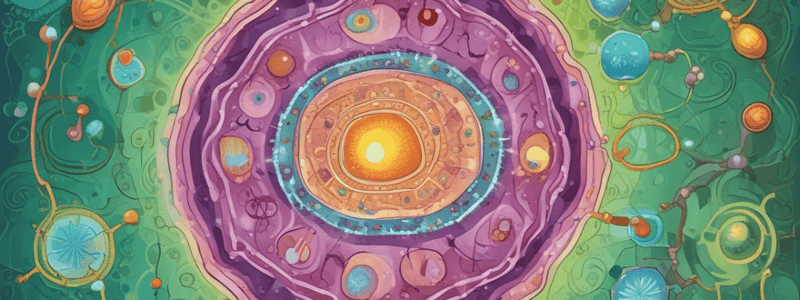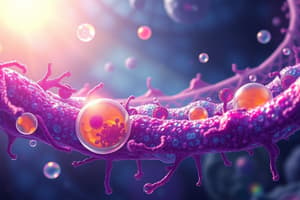Podcast
Questions and Answers
What is the approximate volume range of most cells?
What is the approximate volume range of most cells?
- 10,000-20,000 µm³
- 100-500 µm³
- 5,000-10,000 µm³
- 1,000-5,000 µm³ (correct)
What is the primary function of an organelle?
What is the primary function of an organelle?
- To provide structural support to the cell
- To synthesize proteins
- To perform specific, integrated activities (correct)
- To regulate cell growth and replication
Which of the following is NOT a characteristic of a cell?
Which of the following is NOT a characteristic of a cell?
- Completely dependent on other cells (correct)
- Has mechanisms for metabolism, growth, and replication
- Surrounded by a membrane
- Semi-independent, living unit
What is the term for an organized assembly of cells and their extracellular products?
What is the term for an organized assembly of cells and their extracellular products?
What is the term for an assembly of organs with specific, related activities?
What is the term for an assembly of organs with specific, related activities?
What is the volume of an erythrocyte?
What is the volume of an erythrocyte?
What is the volume of an oocyte?
What is the volume of an oocyte?
What is the term for a subunit within a cell with a defined structure and specific function?
What is the term for a subunit within a cell with a defined structure and specific function?
Which organelle is responsible for directing new proteins within vesicles to their correct location in the cell?
Which organelle is responsible for directing new proteins within vesicles to their correct location in the cell?
What is the primary function of the smooth endoplasmic reticulum?
What is the primary function of the smooth endoplasmic reticulum?
Which organelle is involved in the synthesis of proteins for secretion or insertion into the cell membrane?
Which organelle is involved in the synthesis of proteins for secretion or insertion into the cell membrane?
What is the site of glycosylation modifications in the cell?
What is the site of glycosylation modifications in the cell?
Which organelle is responsible for the assembly of proteins?
Which organelle is responsible for the assembly of proteins?
What is the function of the Cys-Cys bridges in protein structure?
What is the function of the Cys-Cys bridges in protein structure?
Which organelle is responsible for transporting membrane lipids around the cell?
Which organelle is responsible for transporting membrane lipids around the cell?
What is the site of formation of lysosomes in the cell?
What is the site of formation of lysosomes in the cell?
What is the primary function of lysosomes?
What is the primary function of lysosomes?
What is the main difference between prokaryotes and eukaryotes?
What is the main difference between prokaryotes and eukaryotes?
What is the function of peroxisomes?
What is the function of peroxisomes?
What is the function of cilia?
What is the function of cilia?
What is the function of secretory vesicles?
What is the function of secretory vesicles?
What is the function of the extracellular matrix?
What is the function of the extracellular matrix?
What is a characteristic of prokaryotes?
What is a characteristic of prokaryotes?
What is the pH of the interior of lysosomes?
What is the pH of the interior of lysosomes?
What is the primary limitation to the size of a cell?
What is the primary limitation to the size of a cell?
Which of the following is NOT a solution to the problem of diffusion at distances >50µm?
Which of the following is NOT a solution to the problem of diffusion at distances >50µm?
What is the range of resolution of a light microscope?
What is the range of resolution of a light microscope?
What is the function of the nuclear membrane/nuclear envelope?
What is the function of the nuclear membrane/nuclear envelope?
What is the function of the cytoskeleton in animal cells?
What is the function of the cytoskeleton in animal cells?
What is the function of the nucleolus in animal cells?
What is the function of the nucleolus in animal cells?
What is the function of mitochondria in animal cells?
What is the function of mitochondria in animal cells?
What is the minimum resolvable unaided by eye?
What is the minimum resolvable unaided by eye?
What is the range of resolution of an electron microscope?
What is the range of resolution of an electron microscope?
What is the purpose of the cytosol in animal cells?
What is the purpose of the cytosol in animal cells?
What is the key characteristic of eukaryotes in terms of their genetic material?
What is the key characteristic of eukaryotes in terms of their genetic material?
Which of the following organelles is present in eukaryotic cells but absent in prokaryotic cells?
Which of the following organelles is present in eukaryotic cells but absent in prokaryotic cells?
What is the main difference between prokaryotic and eukaryotic cells in terms of their cell division?
What is the main difference between prokaryotic and eukaryotic cells in terms of their cell division?
Which of the following is a characteristic of viruses?
Which of the following is a characteristic of viruses?
What is the main difference between prokaryotic and eukaryotic cells in terms of their internal membranes?
What is the main difference between prokaryotic and eukaryotic cells in terms of their internal membranes?
What is the function of the endoplasmic reticulum in eukaryotic cells?
What is the function of the endoplasmic reticulum in eukaryotic cells?
Which of the following is a characteristic of eukaryotic cells?
Which of the following is a characteristic of eukaryotic cells?
What is the main difference between prokaryotic and eukaryotic cells in terms of their ribosomes?
What is the main difference between prokaryotic and eukaryotic cells in terms of their ribosomes?
Flashcards are hidden until you start studying
Study Notes
Cell Biology Definitions
- Cell: a semi-independent, living unit within the body, consisting of an aqueous solution of organic molecules surrounded by a membrane.
- Organelle: a subunit within a cell, with a defined structure and performing specific, integrated activities.
- Tissue: an organised assembly of cells and their extracellular products, carrying out similar and coordinated activities within the body.
- Organ: an assembly of tissues coordinated to perform specific functions within the body.
- System: an assembly of organs with specific, related activities, sharing regulatory influences.
Limitations on Cell Size
- The maximum size of a cell is limited by the rate of diffusion, which affects the movement of metabolites within the cell, uptake of oxygen, and movement of mRNA from the nucleus.
- Solutions to these limitations include the use of cytoskeleton to actively move things around cells, creation of “giant” cells with multiple nuclei, and gap junctions between cells for efficient movement of metabolites.
Methods to Visualize Cells and Organelles
- Light microscope: limited ability to visualize components of cells (only nucleus and plasma membrane can be resolved).
- Electron microscope (EM): needed to visualize full range of organelles, but sample preparation is highly artificial, and cells are dead, fixed, and dehydrated.
Definitions and Functions of Organelles in Animal Cells
- Plasma membrane: phospholipid bilayer that defines the boundary of the cell and regulates entry and exit of chemicals.
- Cytosol: aqueous environment within the plasma membrane.
- Cytoskeleton: consists of three types of protein polymers, providing mechanical strength, controlling shape, and facilitating movement.
- Nucleus: the largest organelle, surrounded by a nuclear membrane, storing chromosomes and site of DNA replication and gene expression.
- Nucleolus: region of the nucleus where rRNA synthesis and ribosome biogenesis occur.
- Nuclear membrane/nuclear envelope: regulates the entrance and exit of mRNA and proteins, maintaining the integrity of the nucleus.
- Mitochondria: surrounded by a double membrane, performing aerobic oxidation of glucose to generate ATP, involved in oxidation of fatty acids and gluconeogenesis.
- Rough endoplasmic reticulum (RER): continuous from the outer nuclear membrane, involved in mRNA translation and synthesis of proteins for secretion or insertion into the cell membrane.
- Smooth endoplasmic reticulum (SER): involved in biosynthesis of membrane lipids and steroids, and detoxification of xenobiotics.
- Ribosome: protein-rRNA complex responsible for the translation of mRNA and synthesis of proteins.
- Golgi apparatus: directs new proteins within vesicles to their correct location in the cell, involved in glycosylation modifications and synthesis/packaging materials to be secreted.
- Secretory vesicles: bud off from the Golgi, fusing with the inner surface of the plasma membrane, and releasing their contents (exocytosis).
- Lysosome: involved in autophagy, organelle turnover, and replacement, with a low pH maintained by an ATPase proton pump.
- Peroxisome: involved in detoxification, phospholipid synthesis, and oxidation of Very Long Chain Fatty Acids (VLCFA).
- Cilia: hair-like extensions of the plasma membrane, involved in sensing movement of fluid, moving liquid, and detecting sound.
- Extracellular matrix (ECM): protein and carbohydrate supporting network outside of cells, providing mechanical support for cells/tissues.
Definitions of Eukaryote, Prokaryote, and Virus
- Prokaryote: single-celled organism with a circular chromosome, no nucleus, and no membranous organelles (e.g., bacteria).
- Eukaryote: one or more cells with chromosomes enclosed in a nucleus, typically having cytoplasmic, membrane-bound organelles, and DNA divided into a series of linear chromosomes.
- Virus: an assemblage of nucleic acid (DNA or RNA) and proteins, parasitic on prokaryotes/eukaryotes, invading cells, subverting protein synthesis machinery, and escaping to infect other cells.
Comparison of Prokaryote and Eukaryote Cells
- Mitotic spindle: absent in prokaryotes, present in eukaryotes.
- Sterols in plasma membrane: absent in prokaryotes, present in eukaryotes.
- Internal membranes: absent in prokaryotes, present in eukaryotes.
- Endoplasmic reticulum: absent in prokaryotes, present in eukaryotes.
- Mitochondria: absent in prokaryotes, present in eukaryotes.
- Lysosomes: absent in prokaryotes, present in eukaryotes.
- Golgi apparatus: absent in prokaryotes, present in eukaryotes.
- Peroxisomes: absent in prokaryotes, present in eukaryotes.
- Cytoskeleton: absent in prokaryotes, present in eukaryotes.
- Cell wall: present in prokaryotes, absent in eukaryotes (except for some fungi).
Comparison of Prokaryote and Eukaryote Cells - Genetic Material
- Chromosomes: single circular in prokaryotes, paired linear in eukaryotes.
- Location: nuclear region in prokaryotes, membrane-bound nucleus in eukaryotes.
- Nucleolus: absent in prokaryotes, present in eukaryotes.
- Histones: absent in prokaryotes, present in eukaryotes.
- Extrachromosomal DNA: present in plasmids in prokaryotes, present in mitochondria and plasmids in eukaryotes.
- Ribosomes: 70S in prokaryotes, 80S cytoplasmic and 70S mitochondrial in eukaryotes.
- Cell division: binary fission in prokaryotes, mitosis or meiosis in eukaryotes.
Studying That Suits You
Use AI to generate personalized quizzes and flashcards to suit your learning preferences.




